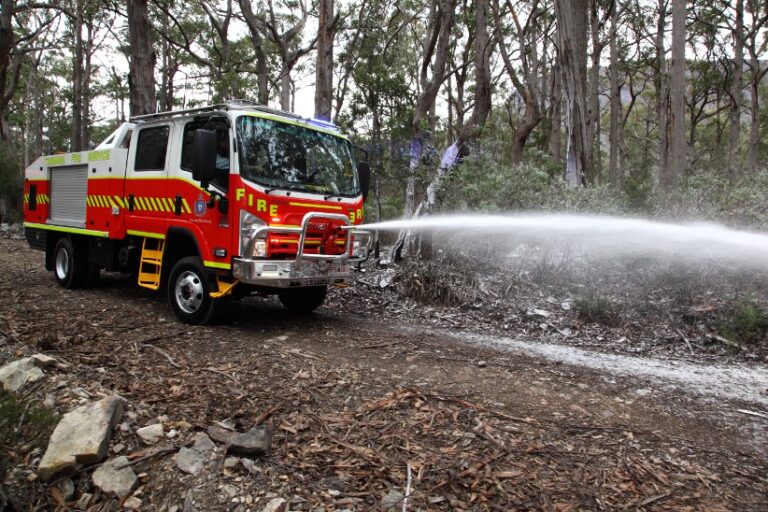Across Australia this fire season, dedicated fire crews will potentially devote their lives to tackling some of Australia’s most dangerous urban and regional blazes.
It’s a testing time for fire fighters all over the country and the Tasmania Fire Service (TFS) is no exception. Only a few months ago the service tackled about 20 fires burning out of control across the island state, mostly in remote bush areas, off the back of unseasonably high temperatures.
With decades of experience fighting fires, it’s still always at the back of Tasmania Fire Service Fleet Manager, Leon ‘Alfie’ Smith’s mind come summer holiday time.
Although, Isuzu’s innovation teamed with Alfie’s industry experience, has produced an exciting development that puts TFS at the forefront of industry innovation and in the best position possible to tackle whatever the hot season brings their way.
With a long history of using Isuzu 4x4s, it seemed only natural the TFS would work with Isuzu to optimise the NPS 300 4×4 Crew’s firefighting capacity even further – introducing the nation’s first integrated compressed air foam system (CAFS).
Presented at the 2015 Australasian Fire and Emergency Services Authorities Council (AFAC) conference and exhibition, the customised NPS and brand new CAFS marked a ground-breaking moment for Australian fire service fleets.
On site at AFAC 2015, Alfie spoke about the Isuzu and the optimised NPS 300 4×4.
“For the TFS, this AFAC marks a very proud moment.
“In conjunction with IAL, we wanted to see what we could actually bring to the industry, and we think the ability to integrate the CAFS onto a platform of this size has been a bit of a game changer on a national level.
“Traditionally it has been a 10 tonne chassis with the same amount of water, without compressed air foam on it. Being able to have a smaller vehicle with a big water capacity gives significantly more flexibility in the off-road firefighting application.”
In 2014 Isuzu increased the GVM rating from 6,500 kg to 7,500 kg for Fire and Emergency Services working with the NPS 4×4 single or crew models, paving the way for the TFS’ future innovations.
“With an Isuzu 4HK1-TCN engine and a maximum power output of 118 kW (158 HP) @ 2,600 RPM, the additional 1,000 kg payload meant practical benefits for the emergency services industry, and ultimately a safer fire service for everyone,” Alfie said.
“When we set out to actually scope the defined role and capabilities at 7.5 tonne compared to the previous 6.5 we had, there was clearly an opportunity to look at what could be achieved with that extra 1,000 kg of available mass.
“We wanted to increase water capacity and to bring along some of the value-add components, like embracing the compressed air foam capabilities onto the platform.”
In tangible terms, the extra 1,000 kg payload capacity allowed the TFS to add an additional 500 L of water to the NPS and a complete CAFS powered by an Isuzu engine.
As Tasmania Fire Service deal with rural as well as urban fires, the service has to consider an increased number of safety factors in terms of off-road and vegetation firefighting.
The Isuzu NPS provides driver and passenger airbags, with seatbelt pretensions, double acting hydraulic shock absorbers, and a Hill Start Aid to ensure top class performance in off-road rural bush fires.
“One of the key considerations in appliance development is firefighter safety and we have to consider everything from ergonomics to access and egress from the passenger cell.
“With the NPS 300 4×4 we haven’t had to modify the grab rails or the steps, as they were already ideal for what we needed – that is something that’s been achieved through liaison with the industry previously and that’s a credit to Isuzu.”
TFS has also implemented their own advanced safety communication systems which ensure the dedicated crew are kept as safe as possible while battling some of Tassie’s fiercest blazes.
“We have a crew detection system activated in this vehicle which enables us to see who the occupants of the truck are, where it’s located, how much water and foam is on board, how and how much they’re using during a fire.
“From there we can make tactical decisions about how long the duration will be before they’ll need additional help,” Alfie said.
“With the added safety systems that we’ve automated now, we’ve eliminated the need for individuals to rely on conveying messages when they’re under duress.
“As a package, considering the ergonomics, what it can achieve for firefighting effectiveness, and the enhanced crew safety systems; our new NPS set-up is absolutely a ground breaker.”






